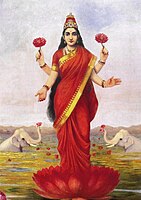Gajalakshmi

Gajalakshmi, also spelt as Gajalaxmi, meaning Lakshmi with elephants, is one of the most significant Ashtalakshmi aspects of the Hindu goddess Lakshmi. In this aspect, the goddess is depicted seated on a lotus, flanked on both side by an elephant (gaja). She is shown as seated in Padmasana yogic posture, and has four arms. In each of her upper pair of arms, she carries a lotus, and the lower hands are generally shown in abhya and varadamudra. The elephants flanking her are shown as "lustrating" her, pouring water from their trunk over the goddess.[1] This aspect like most other aspects of Lakshmi is representative of prosperity, good luck, and abundance; and the Gajalakshmi motifs are very common in Hindu and Buddhist iconography.[2]
Depicitons[]
An image is found from the 2nd century BCE, possibly in Buddhist contexts,[3] and appears on the railings from the Buddhist site of Bharhut, from 125-100 BCE. It appears on a 1st-century BCE coin of Azilises, and a 3rd-century CE coin from Kausambi. One or two elephants depicted alongside a woman symbolized the birth of Gautam Buddha.
Temples in Odisha in the classic local Kalinga architecture style very often have a figure of Gajalakshmi in lalitasana as their lalatabimba or central protective image over the doorway to a temple or the sanctuary of one. One of the Tympana at the Temple of Banteay Srei, Siem Reap, Cambodia, has a beautifully sculptured image of The Goddess GajaLakshmiJi in Pink SandStone. Though over a thousand years old, this tympanum is almost as good a state as it must been when created.
Gajalakshmi is worshiped in many places in Goa and Konkan as a fertility goddess, mostly under the names Gajantlakshmi, Gajalakshmi, Kelbai or Bhauka devi, by various Konkani communities as their tutelary deity.[4]
According to Timothy Taylor, there might be a connection between the female deity with elephants portrayed on plate B of the Gundestrup cauldron and Gajalakshmi.[5]
Gallery[]

Cave 16 (Kailasa Temple), Ellora Caves
Gajalaxmi medallion from Bharhut stupa railing pillar, sandstone, 125-100 BCE. Indian Museum, Kolkata

1st century BCE

Coin of Azilises, 1st century BCE

Over the doorway of the Buddhist Monastery 1 at Ratnagiri, Odisha

Odisha, 18th century

Raja Ravi Varma, Goddess Lakshmi, 1896
Citations[]
- ^ "Gaja Lakshmi, Goddess of Elephants | Ashtalakshmi Pooja – Rosebazaar India". hoovufresh.com. Retrieved 30 November 2021.
- ^ "Gaja Lakshmi - Avatar of the Divine Mother Lakshmi - Astroved Pedia". www.astroved.com. Retrieved 30 November 2021.
- ^ Coomaraswamy, Ananda, Elements of Buddhist Iconography, Harvard University Press, p. 22, 1935, online text
- ^ "Gajalaxhmi: The goddess of Rain" (Buzz). Navhind times. 7 August 2014. Retrieved 30 May 2016.
- ^ Taylor, Timothy (1992), “The Gundestrup cauldron”, Scientific American, 266: 84-89. ISSN 0036-8733
References[]
| Wikimedia Commons has media related to Gaja Lakshmi. |
- Dictionary of Hindu Lore and Legend (ISBN 0-500-51088-1) by Anna Dallapiccola
- Lakshmi
- Hindu iconography







